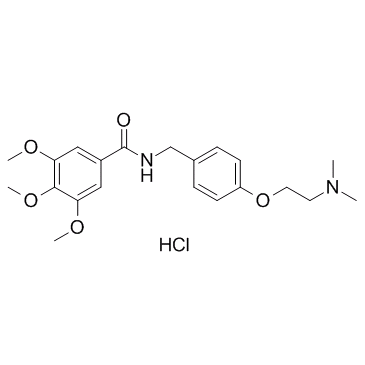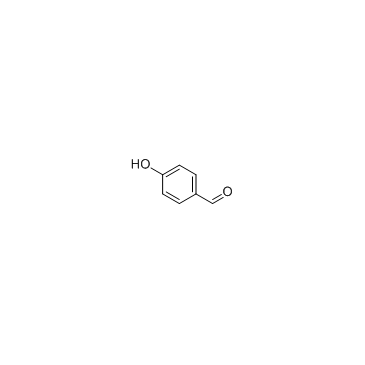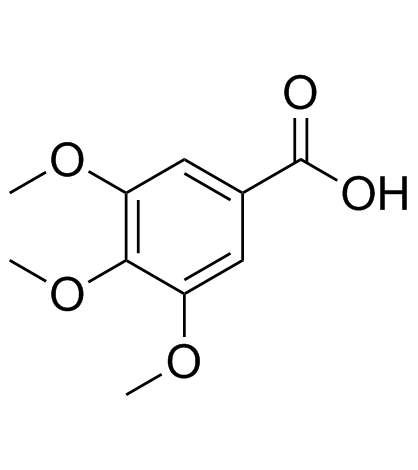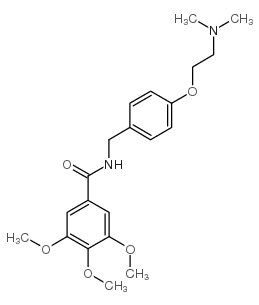554-92-7
| Name | N-[[4-[2-(dimethylamino)ethoxy]phenyl]methyl]-3,4,5-trimethoxybenzamide,hydrochloride |
|---|---|
| Synonyms |
Ametik hydrochloride
Trimethobenzamide hydrochloride 3,4,5-trimethoxy-benzoic acid-[4-(2-dimethylamino-ethoxy)-benzylamide],hydrochloride Trimethobenzamide HCL Ibikin UNII-WDQ5P1SX7Q EINECS 209-075-6 Tigan 3,4,5-Trimethoxy-benzoesaeure-[4-(2-dimethylamino-aethoxy)-benzylamid],Hydrochlorid N-(4-(2-(Dimethylamino)ethoxy)benzyl)-3,4,5-trimethoxybenzamide hydrochloride Poligerim Anaus N-[p-[(2-dimethylamino)ethoxy]benzyl]-3,4,5-trimethoxybenzamide hydrochloride Nauseton trimethoxybenzamide hydrochloride trimethobenzamide chlorohydrate |
| Description | Trimethobenzamide hydrochloride is a blocker of the D2 receptor. Trimethobenzamide is an antiemetic used to prevent nausea and vomiting. |
|---|---|
| Related Catalog | |
| Target |
D2 receptor[1] |
| In Vitro | Trimethobenzamide is a (non-phenothiazine) benzamide antiemetic that acts centrally to block D2 receptors, thereby inhibiting the medullary chemoreceptor trigger zone by blocking emetic impulses to the vomiting center[1]. |
| In Vivo | The oral bioavailability of Trimethobenzamide is 60% to 100%. The time to peak is about 45 minutes after oral administration and; Intramuscular (I.M.) administration about 30 minutes after intramuscular administration[1]. |
| References |
[1]. Smith HS, et al. Dopamine receptor antagonists. Ann Palliat Med. 2012 Jul;1(2):137-42. |
| Density | 1.131g/cm3 |
|---|---|
| Boiling Point | 506.9ºC at 760mmHg |
| Melting Point | 187.5-190° |
| Molecular Formula | C21H29ClN2O5 |
| Molecular Weight | 424.91800 |
| Exact Mass | 424.17600 |
| PSA | 69.26000 |
| LogP | 3.77570 |
| Storage condition | 2-8°C |
|
Section 1. Chemical Product and Company Identification Trimethobenzamide Hydrochloride Common Name/ Trade Name Trimethobenzamide Hydrochloride Section 3. Hazards Identification Potential Acute Health Effects Hazardous in case of skin contact (irritant), of eye contact (irritant), of ingestion, of inhalation.
Potential Chronic HealthCARCINOGENIC EFFECTS: Not available. EffectsMUTAGENIC EFFECTS: Not available. TERATOGENIC EFFECTS: Not available. DEVELOPMENTAL TOXICITY: Not available. Repeated or prolonged exposure is not known to aggravate medical condition. Section 4. First Aid Measures Eye ContactCheck for and remove any contact lenses. In case of contact, immediately flush eyes with plenty of water for at least 15 minutes. Get medical attention. Skin ContactIn case of contact, immediately flush skin with plenty of water. Cover the irritated skin with an emollient. Remove contaminated clothing and shoes. Wash clothing before reuse. Thoroughly clean shoes before reuse. Get medical attention. Serious Skin ContactWash with a disinfectant soap and cover the contaminated skin with an anti-bacterial cream. Seek immediate medical attention. InhalationIf inhaled, remove to fresh air. If not breathing, give artificial respiration. If breathing is difficult, give oxygen. Get medical attention. Serious InhalationNot available. Ingestion Do NOT induce vomiting unless directed to do so by medical personnel. Never give anything by mouth to an unconscious person. If large quantities of this material are swallowed, call a physician immediately. Loosen tight clothing such as a collar, tie, belt or waistband. Serious IngestionNot available. Section 5. Fire and Explosion Data Flammability of the Product May be combustible at high temperature. Auto-Ignition Temperature Not available. Flash PointsNot available. Flammable LimitsNot available. Products of CombustionThese products are carbon oxides (CO, CO2), nitrogen oxides (NO, NO2...). Fire Hazards in Presence of Slightly flammable to flammable in presence of heat. Various SubstancesNon-flammable in presence of shocks. Explosion Hazards in Presence Risks of explosion of the product in presence of mechanical impact: Not available. of Various SubstancesSlightly explosive in presence of open flames and sparks. Non-explosive in presence of heat. Fire Fighting MediaSMALL FIRE: Use DRY chemical powder. and InstructionsLARGE FIRE: Use water spray, fog or foam. Do not use water jet. Special Remarks onAs with most organic solids, fire is possible at elevated temperatures Fire Hazards Special Remarks on Explosion Fine dust dispersed in air in sufficient concentrations, and in the presences of an ignition source is a potential dust Hazardsexplosion hazard. Trimethobenzamide Hydrochloride Section 6. Accidental Release Measures Small SpillUse appropriate tools to put the spilled solid in a convenient waste disposal container. Finish cleaning by spreading water on the contaminated surface and dispose of according to local and regional authority requirements. Large SpillUse a shovel to put the material into a convenient waste disposal container. Finish cleaning by spreading water on the contaminated surface and allow to evacuate through the sanitary system. Section 7. Handling and Storage PrecautionsKeep away from heat. Keep away from sources of ignition. Do not ingest. Do not breathe dust. Wear suitable protective clothing. In case of insufficient ventilation, wear suitable respiratory equipment. If ingested, seek medical advice immediately and show the container or the label. Avoid contact with skin and eyes. StorageKeep container tightly closed. Keep container in a cool, well-ventilated area. Section 8. Exposure Controls/Personal Protection Engineering ControlsUse process enclosures, local exhaust ventilation, or other engineering controls to keep airborne levels below recommended exposure limits. If user operations generate dust, fume or mist, use ventilation to keep exposure to airborne contaminants below the exposure limit. Personal ProtectionSplash goggles. Lab coat. Dust respirator. Be sure to use an approved/certified respirator or equivalent. Gloves. Personal Protection in Case of Splash goggles. Full suit. Dust respirator. Boots. Gloves. A self contained breathing apparatus should be used a Large Spillto avoid inhalation of the product. Suggested protective clothing might not be sufficient; consult a specialist BEFORE handling this product. Exposure LimitsNot available. Section 9. Physical and Chemical Properties Physical state and appearance Solid.OdorNot available. Not available. Taste Molecular Weight42492 g/mole Not available. Color pH (1% soln/water)Not available. Boiling PointNot available. Melting Point186°C (366.8°F) Critical TemperatureNot available. Specific GravityNot available. Not applicable. Vapor Pressure Vapor DensityNot available. Not available. Volatility Odor ThresholdNot available. Water/Oil Dist. Coeff.Not available. Ionicity (in Water)Not available. Dispersion PropertiesNot available. SolubilityNot available. Trimethobenzamide Hydrochloride Section 10. Stability and Reactivity Data The product is stable. Stability Instability TemperatureNot available. Excess heat, dust generation, incompatible materials Conditions of Instability Not available. Incompatibility with various substances CorrosivityNot available. Special Remarks onNot available. Reactivity Special Remarks onNot available. Corrosivity PolymerizationWill not occur. Section 11. Toxicological Information Routes of EntryInhalation. Ingestion. Toxicity to AnimalsAcute oral toxicity (LD50): 1600 mg/kg [Mouse]. Chronic Effects on Humans Not available. Other Toxic Effects onHazardous in case of skin contact (irritant), of ingestion, of inhalation. Humans Special Remarks onNot available. Toxicity to Animals Special Remarks onNot available. Chronic Effects on Humans Special Remarks on otherAcute Potential Health Effects: Toxic Effects on HumansSkin: May cause skin irritation. Eyes: May cause eye irritation. Inhalation: May cause respiratory tract irritation. Ingestion: May be harmful if swallowed. May cause gastrointestinal tract irritation. May affect respiration (dyspnea) The toxicological properties of this substance have not been fully investigated. Section 12. Ecological Information EcotoxicityNot available. BOD5 and CODNot available. Products of BiodegradationPossibly hazardous short term degradation products are not likely. However, long term degradation products may arise. Toxicity of the ProductsThe products of degradation are less toxic than the product itself. of Biodegradation Special Remarks on theNot available. Products of Biodegradation Trimethobenzamide Hydrochloride Section 13. Disposal Considerations Waste DisposalWaste must be disposed of in accordance with federal, state and local environmental control regulations. Section 14. Transport Information DOT ClassificationNot a DOT controlled material (United States). Not applicable. Identification Not applicable. Special Provisions for Transport DOT (Pictograms) Section 15. Other Regulatory Information and Pictograms No products were found. Federal and State Regulations California Proposition 65 Warnings Other RegulationsEINECS: This product is on the European Inventory of Existing Commercial Chemical Substances. WHMIS (Canada) Not controlled under WHMIS (Canada). Other Classifications DSCL (EEC)R36/38- Irritating to eyes and skin.S2- Keep out of the reach of children. S46- If swallowed, seek medical advice immediately and show this container or label. Health Hazard HMIS (U.S.A.)2 National Fire Protection 1 Flammability 1 Association (U.S.A.) Fire Hazard 2 0 Reactivity Health Reactivity 0 Specific hazard Personal Protection E WHMIS (Canada) (Pictograms) DSCL (Europe) (Pictograms) TDG (Canada) (Pictograms) Trimethobenzamide Hydrochloride ADR (Europe) (Pictograms) Protective Equipment Gloves. Lab coat. Dust respirator. Be sure to use an approved/certified respirator or equivalent. SECTION 16 - ADDITIONAL INFORMATION N/A |
CHEMICAL IDENTIFICATION
HEALTH HAZARD DATAACUTE TOXICITY DATA
|
| Symbol |


GHS07, GHS08 |
|---|---|
| Signal Word | Danger |
| Hazard Statements | H302-H317-H334 |
| Precautionary Statements | P261-P280-P284-P301 + P312 + P330-P304 + P340-P342 + P311 |
| Risk Phrases | 20/21/22 |
| Safety Phrases | 36 |
| RIDADR | UN 2811 6.1/PG 2 |
| WGK Germany | 3 |
| HS Code | 2924299090 |
|
~% 
554-92-7 |
| Literature: Organic Process Research and Development, , vol. 17, # 7 p. 981 - 984 |
|
~% 
554-92-7 |
| Literature: Organic Process Research and Development, , vol. 17, # 7 p. 981 - 984 |
|
~% 
554-92-7 |
| Literature: Organic Process Research and Development, , vol. 17, # 7 p. 981 - 984 |
|
~% 
554-92-7 |
| Literature: Neelakandan; Manikandan; Santosha; Prabhakaran Organic Process Research and Development, 2013 , vol. 17, # 7 p. 981 - 984 |
| HS Code | 2924299090 |
|---|---|
| Summary | 2924299090. other cyclic amides (including cyclic carbamates) and their derivatives; salts thereof. VAT:17.0%. Tax rebate rate:13.0%. . MFN tariff:6.5%. General tariff:30.0% |





